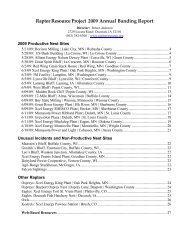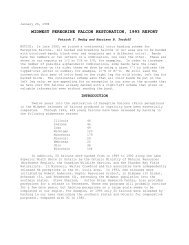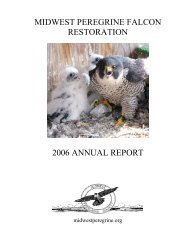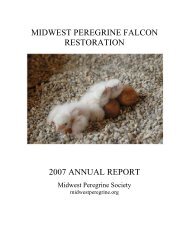2002 - Midwest Peregrine Falcon Restoration Project
2002 - Midwest Peregrine Falcon Restoration Project
2002 - Midwest Peregrine Falcon Restoration Project
You also want an ePaper? Increase the reach of your titles
YUMPU automatically turns print PDFs into web optimized ePapers that Google loves.
8<br />
The evidence suggests that a few pairs may nest undiscovered each year, but it is<br />
clear that the number of unbanded adults on territories is consistent with the number of<br />
unbanded young fledging from known nests. There is no evidence of an undiscovered<br />
population on the order of 10% to 20% of the known population.<br />
It has seemed likely that close monitoring and banding of the peregrine population<br />
in the <strong>Midwest</strong> would ultimately cease as more and more pairs found places to nest<br />
undetected and the population became increasingly unbanded. However, if there is no<br />
substantial undetected population, the proportion of unbanded adults should not increase<br />
unless monitoring and banding taper off. So far that has not happened; unbanded young<br />
in <strong>2002</strong> were 14.8% of the total fledged, consistent with the long-term record. Why<br />
should we continue to keep track of the peregrines? There are at least two good reasons:<br />
first, peregrines are magnetically attractive; watching them and banding the chicks is<br />
intensely satisfying. Also, the database on <strong>Midwest</strong>ern peregrines becomes more<br />
valuable scientifically each year with the addition of new information. Monitoring and<br />
banding at the current level of intensity in the <strong>Midwest</strong> can continue indefinitely, if the<br />
will persists.<br />
Weather and <strong>Peregrine</strong>s Nesting on River Cliffs<br />
The three pairs of peregrines nesting on the west side of the Mississippi, on eastfacing<br />
cliffs, hatched their clutches on May 21 (Queens Bluff), May 23 (John Latsch),<br />
and May 27 (Lansing, IA). The three pairs on the east side of the river on west-facing<br />
cliffs hatched their clutches on June 14 (Castle Rock) and June 18 (Maiden Rock and<br />
Maassen Bluff). Apparently at least two of these pairs (Maiden Rock and Maassen Bluff)<br />
lost their first clutches early in incubation and re-nested, a process that usually takes<br />
about two weeks from loss to start of egg-laying. At Castle Rock, the female was a oneyear-old;<br />
the late hatch may have been the outcome of a late start typical of the first<br />
nesting attempt by a young female. What might have caused simultaneous nest failure<br />
for two pairs on west-facing cliffs spaced about 20 miles apart, while three pairs only a<br />
few miles away on east facing cliffs succeeded with their first clutches? Apparently the<br />
failed clutches were lost in a storm. Snow or rain driven by west winds would drench<br />
cliffs facing west while those facing east would be somewhat sheltered. A major storm<br />
passed through the area from Red Wing, Minnesota, to La Crosse, Wisconsin, on April<br />
21, timing consistent with the nest losses.<br />
It was 91 degrees in Minneapolis on April 15. On April 21, a record 6.2 inches of<br />
snow fell. A peregrine incubating eggs at NSP Riverside, Minneapolis, was<br />
photographed covered with snow on April 21 (John Tradewell). Assuming nest failure<br />
on April 21 at the river cliffs in Wisconsin, add two weeks to start of egg-laying, a week<br />
for egg-laying, five weeks for incubation, and the estimated hatch date would be June 16.<br />
The three successful pairs on the east-facing cliffs (and probably also the pairs that failed)<br />
were about one week into incubation on the date of the storm, April 21. (All of these<br />
nesting dates are estimates made by back-dating from age of chicks at banding.)<br />
Reading Bands<br />
We band young birds primarily to learn about events later in their lives. Color<br />
bands make it possible to follow the lives of individuals by reading their bands without








